Your purpose to start a travel blog can be anything – to share your travel experience, to make money through it, to pour your heart out over your passion for traveling, etc. But the process to create a travel blog remains the same.
Let me start by saying – Starting a travel blog is easy. With the available technologies, anyone thinking of starting a blog can easily do so, in minutes(literally).
No technical skill required.
Without touching a line of code, you can create brilliant, professional looking websites. No need to pay hundreds or thousands of bucks to programmer or web designers to get your website created.
You can do it your own way. Without wasting time or money.
And in the end, you get a website that is totally in your control. And yes, we promise that even though you take the task of website building in your own hands, you will still be spared with enough time to focus on writing and your blogs.
Because the new ways are not just easy at the beginning. They facilitate you to create websites that are almost self-managing and won’t be hard to maintain.
Now, let’s jump to how to start a blog. I have divided this guide according to the different phases of your website building. While some will need you to scratch your head and ask yourself what you want, some are easy peasy technical steps.
So here is a short index on how to start a travel blog:
- Pick a name, one that you’ve always wanted
- Pre-prepare for your travel blog
- Start theme hunting
- Finally, Setting up your travel blog
- Adding your travel blogs/creating galleries
- How to promote your travel blogs?
- Maintaining your travel blog website
- How can you monetize your travel blogs?
- Best Travel blog examples to inspire you
Pick a name before you start your travel blog
If you have been thinking about creating a travel blog for a while, than you already have a name in your mind, don’t you?
I have listed this step as the first step to start your travel blog because it’s interesting and motivating.
Generally, choosing the business name is the first step towards the inception of an enterprise.
If you are starting off your travel blog out of your passion to travel, you probably have at least 10 names in your mind.
Anyways, not to worry if you don’t
Prepare for your travel blog
We are ready to start now.
But before we begin with the technical part, here are a few questions and requirements that needs to be taken care of.
The very first things is: You should be sure about the platform you choose to build your travel blog.
So, Why WordPress and not a website builder?
 If you are already confident that WordPress is great for your travel blog, then you can totally skip this section.
If you are already confident that WordPress is great for your travel blog, then you can totally skip this section.
But if you still have questions in your mind, let us assure you that WordPress is one of the best choices for your travel blog.
Why?
Because of many reasons. Some of them are:
WordPress is for blogs. All type of blogs: Fashion, Travel, Lifestyle, etc.
- WordPress is really easy to use.
- Themes for your blog: Search and there are a number of beautiful theme designs for your blog.
- Plugins make adding new features to your site really easy.
- It is an SEO friendly CMS. In addition, you can use the SEO plugins like Yoast SEO.
- The new Gutenberg blog based editor lets you create beautifully structured pages easily.
- It is easy to customize and manage.
- WordPress is safe and with security plugins, you can add more safety features.
- You have all the freedom to monetize your WordPress based blog.
Therefore, even if I weren’t a part of a WordPress Theme’s company, I would recommend using WordPress for blogs as well as simple business websites.
Rest assured, there’s no learning curve. You can learn new things and make changes/set your website at the same time.
Especially if you have never created or maintained a website before, creating a WordPress site will be a good starting point for you.
Set the domain name and hosting
Next, you need to acquire the domain name for your site, and hosting space, to host your travel blog.
Bluehost is our recommended service for domain and hosting space. It’s best if you acquire the domain name similar to the name of your travel blog.

With the easy interface of Bluehost, you can easily acquire a domain name as well as hosting space for your new website.
This article will help you choose the best domain name and host for your website.
Lists and Checklists
First make a list of all the features you want in your website. For example, you want a theme with a full screen video banner, you want to create a video post, you want the theme to support star based reviews, you want to run a small store along with your travel blog, etc.
Note everything down.
Lists of features, that will help you find a suitable theme. Gives you an outline on what to look for in a theme.
Not just that, this list will help you with many other things while you build your travel blog.
Start a travel blog: Theme hunt
To emphasize how the importance of choosing a theme, I would say “Choose a WordPress theme and your work is done”.
However, it’s not true. The real work starts after you choose a WordPress theme.
A Travel blog WordPress theme can surely help. It makes your task of travel blog building very easy.
What to look in a travel blog theme?
- A good design
- Should have all the features you need in your travel blog
- Must be flexible enough for the customization you want
- Should support images and video, in high quality
- Must be responsive and mobile friendly
- Check if has it is extensible for future additions – eCommerce support, BuddyPress, etc.
Finally, Setting up your travel blog
Mostly all the premium themes come with easy installation features as well as sample data for your travel blog.
Installing the theme + Demo data
You can follow the steps mentioned by your host as well as theme documentation to install the theme.
The steps to install and run the theme on your WordPress is always a quick and easy.
After you install the theme, we also recommend installing the sample data so that you get a better idea on how to use different elements and widgets of the theme.
Once your site is ready with the theme and the sample data installed, you can now proceed to set the colors and other settings of the theme.
Appearance – Colors, Typography, Images, etc.
Any WordPress theme you choose for your travel blog will basically come with some options to manage the color as well as appearance of your site.
To totally personalize your website, you would want to make the following changes:
- Change the site colors
- Change the background color
- Manage the fonts and font family/style
- Set the banner image and text
- Change the other images on your site
- Remove the unwanted sections, add required sections
- Arrange/organize the Sections on your site with the available options.
Besides different themes come with different options to manage your content and customise your travel blog.
Mostly all the WordPress themes are highly customisable. So you can easily use the options available in your theme to customise your site and make it look exactly the way you want.
For guidance on customisations, you can refer the theme guide/documentation that you get with your theme.
Create all the important pages
There can be many pages on your website based on the type of travel blog you have created. However, there are a few pages that you will need regardless of the type of website you have created.
Typically, the following pages are present on a travel blog.
Contact page
A contact form is a very important part of your travel blog. This is the page that allows the visitors to get in touch with you easily.
A contact page typically includes a contact form with the fields name, email and message, etc. A visitor can easily send you a message using this contact form.
This way you can get messages from collaborators, or your fans.
You can even mention your contact number and email address on your contact page if you want. The ultimate goal of the contact page is to make it easy for your visitors to contact you.
About us page

This page is your chance to speak to your visitors about your passion and tell them your story. While the contact form makes it easy for your visitors to contact you, the about page lets your visitors know you better.
You can make the about page of your blog as interesting as possible. You can add pictures, videos and format your about page.
This page helps the visitors connect to the author of the blog, therefore, it plays an important role on your site.
What can be other pages?
There can be several other pages in your website as per your requirements. Creating and managing new pages in WordPress is really easy.
But once you publish a new page, you must make sure that the link to the page appears in the navigational facilities of the website. You can place it in the menu or as a part for sub-menu based on the prominence of the page.
List all the important links and design a menu for your travel blog
Now that we have all the pages ready for our travel blog, is the time to design a menu.
First of all, make a list of all the important pages/links you want to place in the navigational menu. When you have the list ready, prepare a structure of menu and sub-menus items.
Generally, any theme you choose will let you create menus very easily. Menu is an integral part of a website’s navigational structure and it should be prepared with care.
Mostly all the WordPress themes come with easy options to create and manage menus. So it won’t be difficult to create menus on your site once you have the links and the structure decided.
Adding your travel blogs/creating galleries
With the steps mentioned above, you can easily setup your travel blog. Now, is the time to populate it with content for the readers.
Now, is the time to add your first travel blog.
Create categories for your blog
Before you start adding blogs and creating articles, you need to create some categories for your articles.
Blog categories help your readers find the blogs of their interest easily.
These categories can be anything: Food, Tradition, destination, Asia, Europe, photography, etc.
So before you start, create different categories for your blog. And then before you start your blog, make sure you choose a relevant category for it.
Writing your first travel blog

Travel blogging, or blog writing in general needs nothing but the ability to express your opinions or describe your experiences.
You don’t really have to be a professional writer to start travel blog. You can start with what you know and learn as you go.
There are no set of rules that you should follow while drafting your travel blogs. The only thing that matters is honest, original, error free and interesting content that is useful or entertaining to your users.
Following are some of the tips before you start writing your first travel blog:
- Read online blogs. (You will find some of the best travel blog examples listed at the end of this article)
- Decide your topics cleverly. Choose the one’s that are interesting
- Learn some SEO basics that can help you choose the topics, their keywords and LSI
- For writing, use writing and grammar tools
- Include original, error free and to the point content
- Add high-quality images and videos to make your content intuitive
- Spellcheck and proofread before you publish your blog
- Ask for user opinions and suggestions
- Publish content regularly
- Make sure you optimize each blog you publish
- Share your articles on social media
These were some of the basic tips that can help you get started in the right direction. However, with experience and dedication, you will learn more and more about what works for you and what kind of content your users love to read.
How to promote your travel blogs?
Once you have your website ready and running, you would want to promote it for obtaining the desired traffic.
There are different ways for promoting your travel blog. The method that would work for you depends on many things: the location, the type and demographics of the targeted audience, etc.
However, below listed are few of the ways that you could use to promote your travel blog.
Paid promotions
Traffic acquisition at the initial stage is the main struggle. However, paid promotion is an easy way to make people aware of your blog.
There are different ways to pay and promote your blogs on different platforms.
For example, you can promote your blog by paid advertisements on Facebook. Or you can run a PPC campaign to achieve some organic traffic for your site.
On the other hand, you can even connect to an advertisement network or request relevant businesses to display banner advertisements.
SEO optimizing your travel blogs
The only way to survive the competition on the internet is by SEO optimizing your website. You might pay and advertise for a while, but in long run, you need to make sure that your site is doing well on the search engines.
And this is done by making sure that each blog post you write follows strict SEO standards.
What you can do to impress the search engines for better ranks, is publish reader-friendly, interesting and unique content for your readers.
There are also other factors like good interlinking to reduce the exit rates, keyword optimization for relevance of your blog, etc.
However, SEO optimizing your site and individual pages/blog is a separate subject and there’s a lot more to it. Moreover, there are SEO plugins that you can use to optimize your post on your travel blog. For example: Yoast SEO.
Refer this guide on how to SEO optimize your blog post by Yoast.
Social Media Marketing
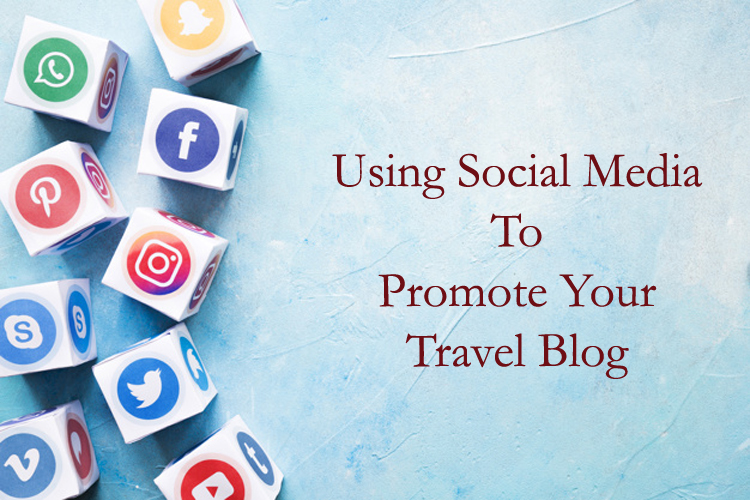
This is the age of social media and it is the best way to reach large groups of people with similar interests.
If you want to spread a word about your travel blog, or a new blog, you can share it on social media.
I also recommend to create a special account on different social media platforms like twitter, facebook, etc and keep your followers regularly posted with interesting content through it.
Besides, make sure that the theme you choose is social media ready. Mostly, all the themes are. Moreover, you can use different social media plugins for WordPress that could help you with social media marketing.
Also Read: Social media marketing guide by Neil Patel
Maintaining your travel blog website
Creating a blog is easy, but the maintenance routines take real efforts.
You cannot just create a website and let put it at a rest. Only regular updating and maintenance can assure the success of your site.
There can be a number of routines that you can perform to properly maintain your site.
Comments and interaction tracking

One of the ways to make your travel blog interactive is by allowing user comments on your site.
This helps your readers express their views on your blog. It helps you discover user involvement, opinions, and adds more readable content on your site.
If you find too many spammy comments, you can use spam filters like Akismet. You can also use ReCaptcha to make sure that content posted on your site is by humans.
Comments help you track user involvement on your site. You must regularly check comments, approve the worthy ones and remove the spam.
Content management
Content is what a blog is all about. And content is what a reader wants from your site.
Regular content management includes the following
- Regularly publishing new content
- Removing old content,
- Updating the outdated content
- Promoting the published content
- Keeping track of the performance
Above listed were some of the basic routines that you must perform on day to day basis to maintain your travel blog.
Google Analytics and performance tracking

When maintaining blogs, Google Analytics is a tool that you should definitely use.
Instead of blindly waiting on for traffic, Google Analytics provides some very useful insights about your website’s performance.
- Total number of visitors on your site
- Performance of individual posts on your site
- Information about the traffic Chanel, source/medium of traffic, etc.
- User retention reports
- Sessions by country and devices
- Exit rates, total visits, average session time, etc.
- Demographics about your visitors
- Comparison of performance between two given periods
- Real-time traffic analytics
The one’s mentioned here are only some of the few reports Google Analytics helps you with. Ultimately, it helps you make important decisions and track the efficiency of ad campaigns or a content strategy.
Here’s a complete guide on How to use Google Analytics for WordPress?
Periodic SEO audits and performance optimization
One of the important part of website maintenance is regular audits to check the speed and visibility of your website.
You cannot just go on publishing new content for your site without making sure that your content is read and visible on the internet.
Regular SEO audits should be conducted to find out visibility problems and solve the challenges that hinder your site’s visibility. It also includes optimizing your content to make sure everything on your site is SEO friendly.
Moreover, you must also speed check your site as well as best ranking posts to make sure that speed is not a problem. You can use different tools like Pingdom, gtmetrix, or speed insights by Google.
Getting rid of unused plugins, expired pages, etc.
Lastly, you would like to get rid of any clutter on your site. This can be in form of plugins that you no longer need, pages that make no sense, extra drafts, redundant content/pages/posts, etc.
You must periodically visit different parts of your site and check of expired content and remove it to avoid confusion. Besides, you can also clearing cache, checking for speed issues and make sure everything is up to date.
User experience is very vital for attracting and maintaining readers on your site. And very small mistakes can adversely effect the overall user experience on your site.
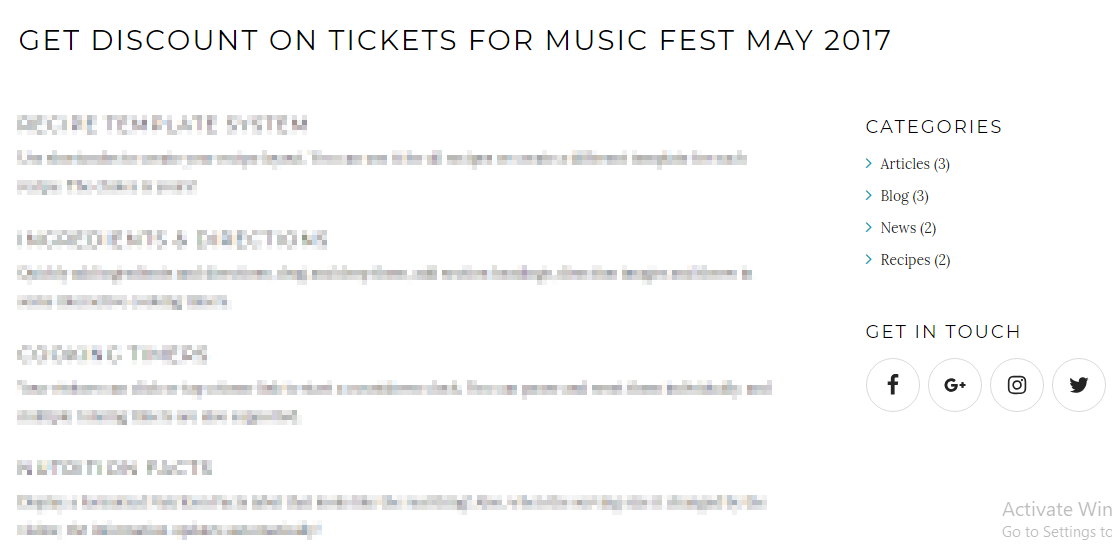
The image depicts a page that was created for a discount deal in May 2017. The deal has expired and therefore the page makes no sense. So you must get rid of this page by deleting it and removing it’s link from the Menu/any other page.
Here’s a complete guide of essential website maintenance routines for an efficient website/blog.
How can you monetize your travel blogs?
Your travel blog will need you to invest your time, money and put in some efforts to manage and maintain it. So it’s only natural to expect something back from your blog.
Here are a few ways to make money through your travel blog:
Sell through your travel blog
Get a plugin like WooCommerce and start a small online store on your travel blog.
Now what you can sell on your travel blog?
Absolutely anything – A travel guide eBook, accessories like customized t shirts, hats, etc., Tickets to events, Sell your photos, imagery, tour packages, etc.
You can even develop your own custom products that are exclusively available on your website.
So on your WordPress website, you can use the WooCommerce plugin to sell products through different pages on your website.
Affiliate links
Affiliate marketing is flourishing and you too can benefit from it. You can create a post with affiliate links on it.
So when a user clicks the link, or buys something on your recommendation, you get a commission.
Affiliate marketing has become one of the easiest ways to earn through your blog. To maintain the affiliate links on your blog, you can use a plugin like Thirsty affiliates.
This plugin makes it really easy to create cloaked affiliate links and track the performance of each of your affiliate links.
For affiliate links based you can create posts like:
- 12 things to pack when you are travelling to Goa
- Travel accessories that you should never leave your home without
Such posts with affiliate links are helpful to your users and also help you earn through the affiliate links of the displayed products.
You can even write an individual blog post for a single affiliate product as a review/recommendation article. For example: Why I never travel without the camping mattress from ABC brand.
Partner brands and hotels, travel agents
Different types of website come with different conditions through which you can earn.
Since we are talking about travel blog, you can partner different brands that sell travel accessories, or travel agents.
Such partnerships generally offer a certain amount of discount or a special offer when the readers are led to their business through your blog.
The partnership can be a help to all the three subjects involved – Your blog, Your partner, Your readers.
For your blog, you get something interesting to offer to your visitors. The readers get recommendations as well as a discount when on your site.
And ultimately, your partners will advantage from your readership. Your blog will be a platform to advertise their service.
Sponsored advertising
If you are travelling and maintaining a travel blog, you can approach certain businesses with a proposal to advertise on your site.
For instance, a travel agent may be interested to advertise of his service on your site.
Another way is that you can display a banner on your site declaring that advertisers and sponsors are welcome to have their advertisements published on your blogs.
These types of advertisements can be either small sections of your website, or a special page/banner designed for the same.
You can decide a fixed charge for the advertisement on your site based on different criterion. When displaying static advertisement banners on your travel blog, you are in total control.
Google AdSense
This one is the best, requires much lesser efforts, and works even for the beginners.
Displaying advertisement banners on your WordPress website is indeed one of the best and the easiest way to make money through your website.
However, it is not always so easy to convince businesses for advertising on your site.
Therefore, the services like Google AdSense are best for such situations. These are the ad network services that you have to subscribe to.
Once subscribed, they will give you a code that you can put at different sections of your website. You are paid on per click or per impression basis.
Such ad networks work on the basis of search history of a user. Therefore, targeted advertisements are displayed that makes sense to your readers. Therefore, such ads convert better than the static advertisement banners.
You can subscribe to the Google AdSense service and start getting advertisement revenue through your travel blog.
Other Advantages
Listed above were the tangible benefits of creating and maintaining a travel blog. However, a travel blog has many other advantages too.
Your blog as your profile for freelance writing
If you want to procure freelance writing assignments, you can list that in your author bio or the About page.
As an author, you can start by writing on your own blog, as well as guest posting on other’s blog. Your own blog is infact the best example of your work.
If you want to advertise your service, you simply need to add a line to your author bio, stating that you are available as a writer for hire. Or you can create a special page “Hire me” to declare that you are available for hire to write blogs/articles.
Build your audience
Your travel blog will also help you build your audience. This audience will know about you and some of them will even follow you closely. Even though you start your travel blog as a hobby, it helps build your name.
You can later use your followers to promote a business, product, etc. Once you have an audience that follows you, you can use it for absolutely any thing. For example: You can use your travel blog to promote your cook book, or a novel that you have written. You can use it to promote your offline store, etc.
Best Travel blog examples to inspire you
You can sure use some examples of successful travel blogs before you start your own. Here are some examples of travel blog with different ideas and purpose.
Solo travel blog: Expert Vagabond

The travel blog expert vagabond is maintained by Matthew Karsten who has an interesting story to tell and lots of experience to share. If you are starting your own travel blog, he has a lot to tell you. Visit Expert Vagabond and it can help you with some precious tips about travel, travel blogging and photography.
Nomadic Matt
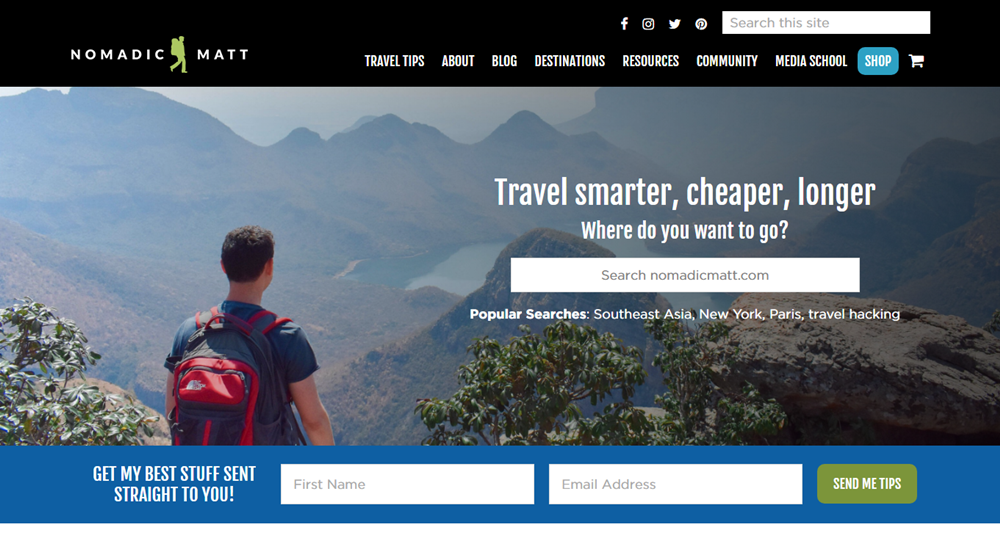
Nomadic Matt’s travel website is the ultimate travelers’ guide. It is full of important tips, resources, information about destinations, recommendations and good reads for any travel enthusiast. There is also a store that sells ebooks and blogging courses.
Family travel blog: The Family Without Borders
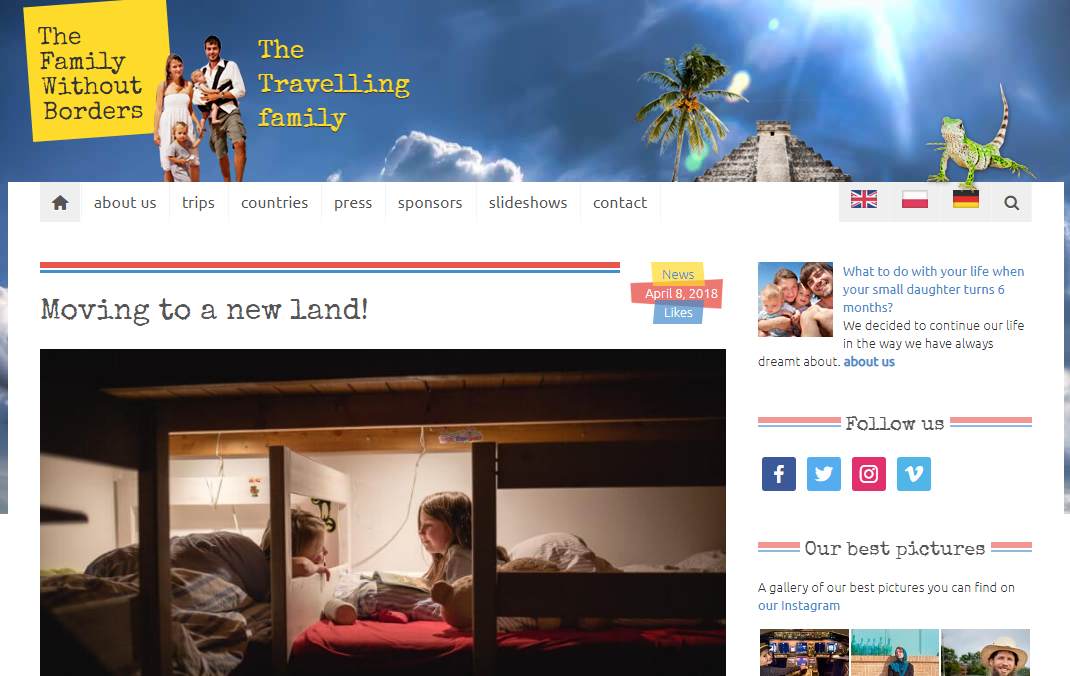
This blog is the adventure of a family of four. Thomas, Anna and their two daughters are all travelers and through the blog Family without borders, they share their travelling experience. It is a simple blog, but they have some very insightful articles about different countries on different subjects. It is a multi-lingual site, it can be viewed in English, German and polish language.
Travel blog + food blog: Eat like a girl

This is a travel plus recipe blog. It is a beautiful combination of a travel blog along with the recipes of different cuisine of different regions. Like other travel blog, there are no travel blogging tips here. The London based blogger Niamh can be hired as a freelance writer and also supports sponsored/partnered content.
Travel blog adventure: Backpacking Man
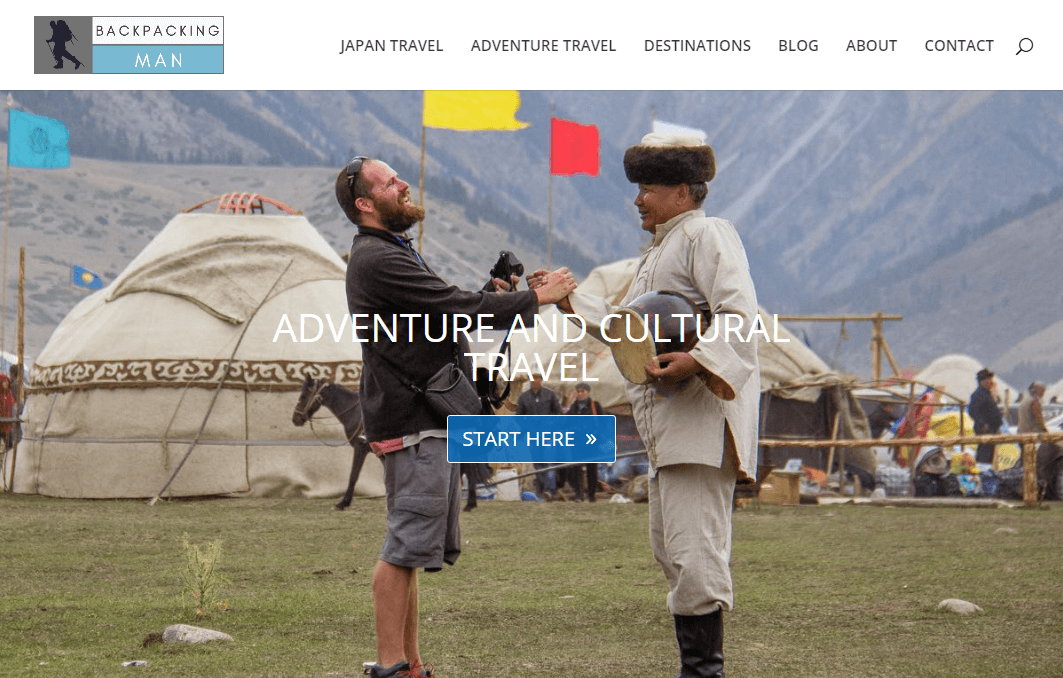
This travel blog has a cultural and adventurous twist to it. The backpacking man travel blog is maintained by Jonny. It it information rich and clearly reflects the author’s passion to travel and explore the world as much as possible. The indepth blogs about places helps this blog to serve as travel guide as well.
Finding the Universe

This blog is maintained by the couple – Laurence and Jessica Norah. It is full of their travel stories and travel photography. They have some experience about destinations as well as a travel photography section too.
Wrapping up
If you are very passionate about your travel blog and writing, than you are going to enjoy your journey to start a travel blog.
With the available technologies, it is really easy to create and manage a travel blog on your own, without investing for web developers to get the job done.
You can use WordPress, setup and run your own travel blog easily. So are you ready to start a travel blog?
If you have experience in travel blogging and wish to share them with our readers, feel free to leave your tips/opinions in the comment section.
Also Read: Blogging for beginners: A complete guide for those who want to start blogging in 2019.

